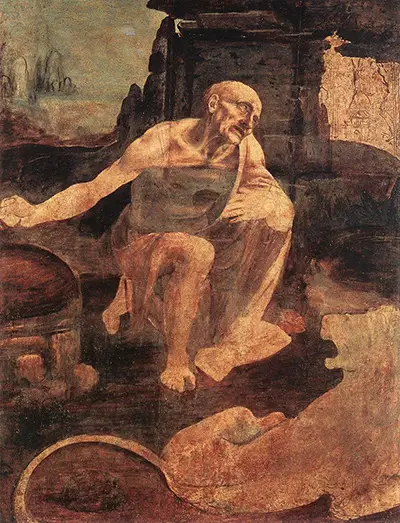It is one of his unfinished paintings currently kept in the Vatican Museums, Rome. Leonardo worked on this painting during the year 1480, a period of great turmoil in his life.
This tempera, oil on walnut panel has a dimension of 41 inches x 30 inches. Even though parts of the painting are sketchy, it holds great importance and gives an unmistakable glimpse into the master’s methods and structure.
The painting is of St Jerome who was a Christian scholar and historian who was best known for his translation of most parts of the Hebrew Gospel into Latin. Jerome was known for his teachings on Christian moral life, guiding and initiating those living in cosmopolitan centres such as Rome into the Christian way of life.
He particularly focused his attention on the lives of women and taught them how to lead their lives as devotees of Christ. This art work shows St Jerome in the Syrian Desert where he was living as an ascetic following his withdrawal from society.
The landscape of this particular painting shows a rocky terrain and St Jerome is shown seated on a rock surface near a cave like structure.
Jerome seems to be gazing towards a faintly drawn crucifix at the extreme top right of the painting. He is holding a small rock in his outstretched right hand using which he is about to strike his chest. During those times this action was considered to be a form of penance.
The background depicts rocky and misty mountains stretching out into the vast expanse.
The painting shows great anatomical details showcasing Leonardo’s vast knowledge of the human anatomy. The saint is shown wearing a long piece of cloth draped around himself. The muscles and bones are clearly visible beneath the thin layer of flesh. The body looks as if it belongs to a young man, but the face is that of an old man.
The cheeks, neck and shoulder muscles are accurate anatomical representations. The face is haggard due to fasting and remorse yet his gaze is determined and unwavering. Seated on the ground next to Jerome’s feet is a lion, which is looking at his actions.
The body language of the lion is casual and is similar to that of a pet animal. Legend has it that the lion became his loyal companion after the saint helped him by removing a thorn from its paws.
The painting has an interesting and almost unbelievable history. It was originally a part of the Vatican collection, and then it came under the care of Angelica Kaufmann.
It was then unknowingly confused as discarded wood, and someone cut it into two pieces. One of the parts was converted into a table top while the other part fell into the hands of a shoemaker who used it as the upper portion of a stool.
Later, Napoleon Bonaparte’s uncle Joseph Cardinal Fesch recognised the table painting in 1820 as he had already seen a replica of the painting somewhere else. He purchased this part from the Roman junk shop where he found it.
He was able to locate the other missing piece several years later. The painting was restored with the cut still visible. It again came back to the Vatican after some years when the heirs of Cardinal Fesch sold the painting to Pope Pius IX.


